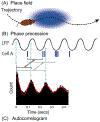Septo-hippocampal dynamics and the encoding of space and time
- PMID: 37479632
- PMCID: PMC10538955
- DOI: 10.1016/j.tins.2023.06.004
Septo-hippocampal dynamics and the encoding of space and time
Abstract
Encoding an event in memory requires neural activity to represent multiple dimensions of behavioral experience in space and time. Recent experiments have explored the influence of neural dynamics regulated by the medial septum on the functional encoding of space and time by neurons in the hippocampus and associated structures. This review addresses these dynamics, focusing on the role of theta rhythm, the differential effects of septal inactivation and activation on the functional coding of space and time by individual neurons, and the influence on phase coding that appears as phase precession. We also discuss data indicating that theta rhythm plays a role in timing the internal dynamics of memory encoding and retrieval, as well as the behavioral influences of these neuronal manipulations with regard to memory function.
Keywords: boundary cells; entorhinal cortex; hippocampus; medial septum; navigation; place cells; retrosplenial cortex; theta rhythm.
Copyright © 2023 Elsevier Ltd. All rights reserved.
Conflict of interest statement
Declaration of interests The authors declare no conflicts of interest.
Figures



References
-
- Milner B et al. (1968) Further analysis of the hippocampal amnesic syndrome: 14-year follow-up study of H.M. Neuropsychologia 6, 215–234
-
- Chrobak JJ et al. (1989) Intraseptal administration of muscimol produces dose-dependent memory impairments in the rat. Behavioral and Neural Biology 52, 357–369 - PubMed
-
- Brioni JD et al. (1990) Muscimol injections in the medial septum impair spatial learning. Brain Res 522, 227–234. 0006-8993(90)91465-S [pii] - PubMed
-
- Givens BS and Olton DS (1990) Cholinergic and GABAergic modulation of the medial septal area: Effect on working memory. Behav. Neurosci 104, 849–855 - PubMed
-
- O'Keefe J. (1976) Place units in the hippocampus of the freely moving rat. Exp Neurol 51, 78–109 - PubMed
Publication types
MeSH terms
Grants and funding
LinkOut - more resources
Full Text Sources

